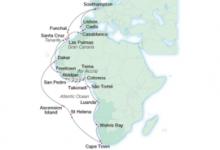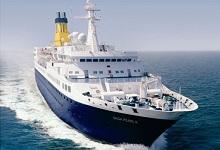Recently Viewed Cruises
- Saga Pearl II, Voyage to the Cape ex Southampton ReturnAdd to favourites
- Polar Pioneer, Across the Arctic Circle ex Aberdeen to LongyearbyenAdd to favourites
- Polar Pioneer, Wild Scotland ex Oban to AberdeenAdd to favourites
- Plancius, Whale Safari ex Aberdeen to LongyearbyenAdd to favourites
- Ortelius, Whale Safari ex Aberdeen to LongyearbyenAdd to favourites
- Royal Caribbean International raises the bar
- Classy Astor fills gap in market
- Oceanic Discoverer
- Ab Fab Oosterdam
- Catch up on Cruising: Latest cruise news in bite size
- Frequently Asked Questions
-
Saga Pearl II, Voyage to the Cape ex Southampton Return
Nights 48 Ship Quest for Adventure Star Rating 
Departs Southampton, England Sailing 2014: 7 Jan Ports of Call Southampton, Funchal (Madeira), Gran Canaria (Las Palmas), Freetown, San Pedro, Abidjan, Takoradi, Tema More Cotonou, Sao Tome, Luanda, Walvis Bay, Cape Town, St Helena, Ascension Island, Dakar, Santa Cruz de Tenerife, Casablanca, Cadiz, Lisbon Please enquire about this cruise for pricing.
48 Night Cruise sailing from Southampton roundtrip aboard Saga Pearl II.
Sweeping landscapes, exotic wildlife and a fascinating colonial past are all yours to discover on this unforgettable 48-night cruise to Africa's southern cape.
Highlights of this cruise:
Southampton
Lying near the head of Southampton Water, a peninsula between the estuaries of the Rivers Test and Itchen, Southampton is Britain's largest cruise port.
It has been one of England's major ports since the Middle Ages, when it exported wool and hides from the hinterland and imported wine from Bordeaux. The city suffered heavy damage during World War Two and as a result the city centre has been extensively rebuilt.
Funchal
Formed by a volcanic eruption, Madeira lies in the Gulf Stream, about 500 miles due west of Casablanca. Discovered by Portuguese explorer João Gonçalves Zarco in 1419, this beautiful island became part of Portugal's vast empire and was named for the dense forest which cloaked it ('Madeira' means 'wood' in Portuguese).
Sugar plantations first brought wealth here and when King Charles II of England granted an exclusive franchise to sell wine to England and its colonies, many British emigrants were drawn to the capital, Funchal.
Freetown
Freetown is Sierra Leone's economic, administrative and financial centre and was founded in 1787 by the British as a settlement for freed slaves. Their descendants are known today as the Creole.
Freetown's economy relies on its harbour, which is the largest natural harbour in Africa, and the third largest in the world. Industries include diamonds, rice milling, petroleum refining and the manufacture of cigarettes.
A treasured landmark is the 'Cotton Tree' which was originally planted by the resettled American slaves with the founding of Freetown.
Takoradi
Takoradi is the sister city to Sekondi. Together they form the oldest twin city and fourth largest city in Ghana. It was dominated by the British and Dutch during the colonial era and this is reflected in the colonial architecture.
Sekondi-Takoradi is also the capital of the Western region of Ghana, with Sekondi being the administrative capital and Takoradi the commercial and industrial hub. This region is noted for its lush vegetation, 75% of which is within the high forest zone of Ghana.
Cotonou
Situated on a strip of land between the Gulf of Guinea and Lake Nokoue, Cotonou is the largest city in Benin and its economic capital. A notable landmark is the cathedral with its distinctive burgundy and white striped exterior.
While here, perhaps join an excursion to the striking stilt village of Ganvie or visit the restored palace of King Toffa on a city tour.
Walvis Bay
Walvis Bay is the gateway to the Namib Desert where towering ochre sand dunes create a stunning backdrop to a scattering of desert-dwelling creatures such as geckoes, jackals, lions, elephants, oryxes and springboks.
Experience this natural wonder for yourself on an optional drive through the sands with a knowledgeable guide.
Cape Town
Sail into Cape Town, which has a spectacular setting dominated by flat-topped Table Mountain.
Spend the day exploring this magnificent capital of the Western Cape. If the weather's fine, why not take the cable car ride to the summit of Table Mountain for unrivalled views, enjoy a boat trip over to poignant Robben Island, or join a tour through the heart of the city?
Then enjoy an evening out in the city, perhaps at one of the fine restaurants surrounding the famous Victoria and Alfred Waterfront.
Dakar
Dakar, set at the tip of the Cape Vert peninsula, is West Africa's westernmost point and the capital of French-speaking Senegal. Although it was not founded until 1857, it is West Africa's oldest European city and one of the most westernised.
The opening of the Dakar-St Louis railway in 1885 put the town on the map; it subsequently became a French naval base and in 1904, the capital of Afrique Occidentale Française. It bears the legacy of Africa's French colonial past, especially so in the downtown Plateau area, where the architecture is redolent of southern France.
Every inch a modern city, Dakar is a frenetic buzz of activity. Perhaps sample the popular mint tea and try your hand at bartering in the colourful craft markets for traditional embroidery, woodcarvings, metalwork and costume jewellery.
Casablanca
The original settlement formed on the site of Casablanca by the Berbers became the kingdom of Anfa, and during the 15th century harboured pirates who raided the Portuguese coast. In retaliation for the attacks, the Portuguese destroyed Anfa and founded the town they called Casa Branca (white house).
They remained here until an earthquake in 1755 and the town was subsequently rebuilt by Mohammed ben Abdallah, whose legacy of mosques and houses remains today in the old Medina. Casablanca acquired its present-day name when the Spanish obtained special port privileges in 1781. The French landed here in 1907, later establishing a protectorate and modelling the town on the port of Marseilles.
Today Casablanca is Morocco's largest city, its most significant port and the centre of commerce and industry. The city is a vibrant fusion of European, African and Arabian influences and its French colonial architecture and art deco buildings seamlessly blend in with the colourful markets.
Cadiz
Believed to be the oldest town on the Iberian Peninsula and founded by Hercules, the Andalusian port of Cadiz enjoys a stunning location at the edge of a six-mile promontory.
The town itself, with 3,000 years of history, is today characterised by pretty white houses with balconies often adorned with colourful flowers. As you wander around be sure to take a stroll through the sizeable Plaza de Espãna, with its large monument dedicated to the first Spanish constitution signed in Cadiz in 1812.
There are two pleasant seafront promenades which boast fine views of the Atlantic Ocean and the Parque Genoves, located close to the sea with an open-air theatre and attractive palm garden. Also notable is the neo-classical cathedral, capped by a golden dome.







